Gossman Knives
Edged Toolmaker
- Joined
- Apr 9, 2004
- Messages
- 9,394
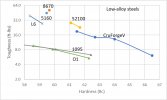
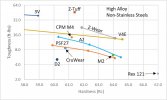
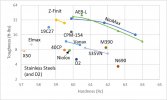
Results are rolling in right now. Vanax appears to have similar toughness to S35VN. L6 was a little worse than 5160 and 8670. Vanadis 4 Extra did well at ~64-65 Rc though another heat treatment with a high temper that resulted in 57 Rc didn't have as big a bump in toughness as might be expected (off the chart). I re-introduced an Elmax value after checking its hardness again (on the low side). 1095 had very similar toughness to O1. Did some higher hardness Rex 121 which was unsurprisingly even less tough than the 67 Rc condition (also not on the chart). I also tested some 1084 which had surprisingly high toughness, but after testing the hardness it was coming out in the 14-20 Rc which makes me think it was never hardened, probably a mistake.
View attachment 1124197
View attachment 1124198
View attachment 1124199
Really starting to fill out man.Results are rolling in right now. Vanax appears to have similar toughness to S35VN. L6 was a little worse than 5160 and 8670. Vanadis 4 Extra did well at ~64-65 Rc though another heat treatment with a high temper that resulted in 57 Rc didn't have as big a bump in toughness as might be expected (off the chart). I re-introduced an Elmax value after checking its hardness again (on the low side). 1095 had very similar toughness to O1. Did some higher hardness Rex 121 which was unsurprisingly even less tough than the 67 Rc condition (also not on the chart). I also tested some 1084 which had surprisingly high toughness, but after testing the hardness it was coming out in the 14-20 Rc which makes me think it was never hardened, probably a mistake.
View attachment 1124197
View attachment 1124198
View attachment 1124199
Well I'm not sure which is a better representation of "reality." It could be that a log scale is closer to how the toughness would be perceived. Regardless, here are the linear scale plots:Wonderful work as always Larrin!
Anyway, this kind of graph doesn't show the different between steel as clear as one in the first page. How to convert these doubled-number to the original one?
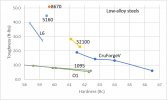
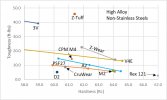
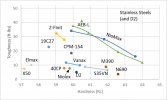
I could not find a sample that read higher than 23 Rc.Did all of the 1084 come out soft? I’m wondering if the steel was mislabeled?
I could not find a sample that read higher than 23 Rc.
So it looks like I am pretty well set for tough knife steels for the foreseeable future. I have stashes of CFV, 3V, 5160, DH III W2 and AEB-L. Also have the odd piece or three of 1 x 1/4 9260 from Admiral and an L6 round too.Interesting tests. Most of the results tracked right along with the charts. There weren't that many surprises but there we're a couple of big ones. Sure, I poked fun at Larrin about this who thread being an infomercial for AEB-L but think about this. Of the top 3 cast steel options, 8670, 5160 in the upper 50's and AEB-L at say 61, which would you want for a knife now that we know that the toughness is close enough to a push for our purposes? I would go with the AEB-L and I am inclined to start telling people that unless they want damascus, a forged integral or a hamon AEB-L is the way to go for their kitchen knife.
Well, we know that 1095 "gains toughness" when you make thick blades because the core does not fully harden and you get the accidental hamon.Btu that chart tells me that there is pretty much no logical reason to leave O1 or 1095 under 60Rc. But wait. haven't we ben saying that for years?
So Spec Ops loves whoever, but 1095 at that super tough proprietary 58Rc is about as tough as CFV........... at 65Rc?!?!?!?Hmmmmm. Think I might have a marketing pitch.
Must have been mislabeled steel.
Much prefer, thanks!Well I'm not sure which is a better representation of "reality." It could be that a log scale is closer to how the toughness would be perceived. Regardless, here are the linear scale plots:
View attachment 1124252
View attachment 1124251
View attachment 1124250
These are about my thoughts too! I’m curious to see if ztuff jumps at 58.And Aeb-l is very impressive. It’s cheap, it’s stainless and it’s tough as hell!So, my next question becomes, for a Canadian hunter in the winter, are you better off with 3v at Rc58, or z-tuff at Rc61? I’m leaning toward z-tuff.
I thought L6 would have matched or beat 8670.
Standouts for me through this are how good aeb-l is, how PM technology results in the balance of toughness/wear resistance in the z-wear/V4e group, and how tough 8670 is. Based on my experience with z-wear, I knew z-tuff would be very tough, but that tough at that hardness is impressive.
So, my next question becomes, for a Canadian hunter in the winter, are you better off with 3v at Rc58, or z-tuff at Rc61? I’m leaning toward z-tuff.
I thought L6 would have matched or beat 8670.
Standouts for me through this are how good aeb-l is, how PM technology results in the balance of toughness/wear resistance in the z-wear/V4e group, and how tough 8670 is. Based on my experience with z-wear, I knew z-tuff would be very tough, but that tough at that hardness is impressive.
